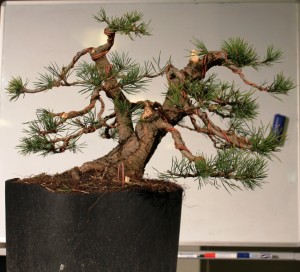The second demonstration was on a Scots Pine (Pinus Sylvestris) and during this demonstration we not only again were able to witness his excellent skill level, but we gained an insight into his bonsai philosophy which was most interesting.
The demonstartion was full of useful advice for the growing and improvement of pine as bonsai and he provided the audience with his techniques for getting a quality pine in a short period of time. Like many others in the audience I will be giving his method a try, but that will mean I need to obtain a pine with a bit of quality before I can commence this process.
A few of Ryan’s philosophies that struck a cord with me are:
- Every time you work on a tree make it the best tree you possibly can
- Get your structure set first
- The most important question you should ask every time you go to work your tree(s) is – can we take this tree a step further?
- And the question after that is – how deep is the rabbit hole and how far down do you want to go?
- Wire must be functional and must look good
- Foliage should frame the best feature of the tree
- ALWAYS MAKE IT THE BEST BONSAI IT CAN POSSIBLY BE!
He discussed the differences in the pine species and the two differing methods to develop the particular species. He told us that Scots pine, Japanese White pine and Mugo pine have similar growth habits (single flush) and we can manage them in a similar way.
During his demonstration I was fascinated with his work and his explanation of the method that he uses and so I “forgot” to get a photographic record of the event, and really didn’t get all the notes I should have as well. But from the few notes I took this is my new plan for Scots and Mugo pines:
- In year 1 build the foligae mass
- In year 2 allow candles to extend then cut allowing two shoots on the current years growth
- Then new shoots on bare branches should grow
- In year 3 develop a good structure
- After 4 years it might be show-able
- And after 5 years in should be good.
These steps along with the needle plucking and fertilizer program will produce a good bonsai as long as the steps are followed.
The only photo is one taken after the demonstration and shows the basic structure so this tree should be a winner in a couple of years.

